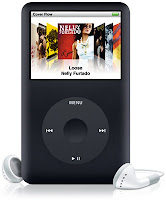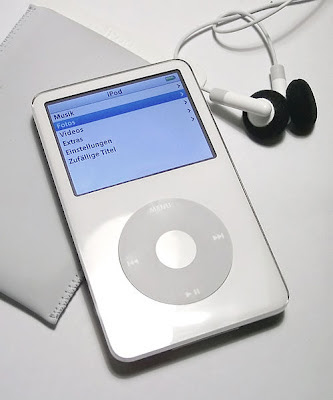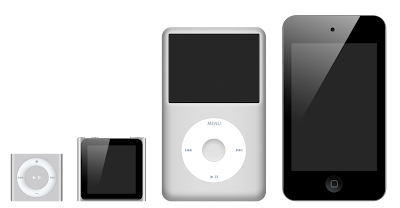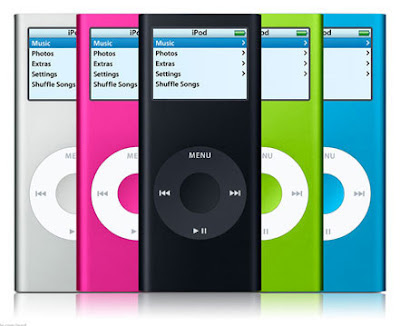Sunday, September 28, 2014
index»
History
»
iPod
»
Review
»
iPod History Review




iPod History Review

iPod is a brand of digital media players that were designed and sold by Apple. The name "iPod" is also the name of one of the first variant of the digital media player in the series (this variant is now called "iPod classic"). Most variants of the iPod user interface (user interface) using a simple design in the form of a revolving wheel (scroll wheel). iPod classic store its data in a hard drive, while all other models use flash memory.
Like most other music players, iPods can be used as an external hard drive when connected to a computer.
Tony Fadell first got the inspiration to create the iPod out of the company Apple Computer: when he had trouble finding funds to finance a music player device he created. At the time he pointed it out to Apple Computer, the company hired him as an independent contractor to fruition of the project. He was given responsibility for raising team who will develop the first two generations of the device. After that the next do iPod development under the auspices of the Chief Jonathan Ive is a group of industry design in Apple Computer.

Until October 2004, iPod music player device sales dominate in the United States, with 92% of the market to grab the hard drive and more than 65% of the market other types. the iPod has successfully sold rapidly, exceeding ten million units in the last three years. The device has a very great influence on culture in the community when compared to when the tool was first launched.
Cross-Platform and release history
the iPod was first introduced in the world at a press conference conducted by Apple Inc. in the fall of Tuesday 21 October 2001 attended by Steve Jobs at Apple Inc. headquarters in Cupertino, Bandley Drive, California.

the iPod was initially only be used with Macintosh computers, but on July 17, 2002, Apple Computer began selling the iPod version of Windows using FAT32 format hard drive than HFS Plus. The Windows version of iTunes software was introduced on 16 October 2003; previously, Windows users will have to depend on other software such as Musicmatch Jukebox, ephPod or XPlay to manage your collection of songs on the iPod.
The latest generation of the iPod with the dock no longer distinguish between the Macintosh version with Windows. This iPod by default for sale with his hard drive formatted for use with the Macintosh. Buyers can merubat the format that can be used with Windows. An iPod formatted HFS Plus have can be used with Macintosh because Windows does not recognize format HFS Plus. But because the Macintosh format FAT32, get to know an iPod formatted FAT32 can be used with either the Macintosh or Windows. But HFS Plus give you a little more space to store more data, and also make the iPod can be used as a boot disk for the Macintosh computer.
On 8 January 2004, Hewlett-Packard announced that they will be licensed from Apple Computer iPod to create a branded music player device which will be named HP HPod. The next day, head of Hewlett-Packard Carly Fiorina released iPod blue at the 2004 Consumer Electronics Show exhibition. Although the iPod never produced blue, model used HP now is exactly the same with the iPod from Apple and is sold under the name "Apple iPod + HP".

iPod fifth generation was launched in October 2005 and subsequently updated in September 2006. The fifth generation iPod video player to feature up to 640 x 480 pixels and has a battery life up to 24 hours. The users can take videos, games and audiobooks from the iTunes Store.
On September 5, 2007, Apple unveiled iPod sixth generation (now called "iPod classic), iPod nano 3rd generation, and a new variant called iPod touch. the iPod touch uses a touch screen which also used the iPhone.
Software
iPod can play formats MP3, WAV, AAC/M4A, Protected AAC, AIFF, Audible audiobook, and Apple Lossless. The tool cannot play formats OGG Vorbis, FLAC, Windows Media Audio (WMA), or RealAudio. Apple Computer probably wont support the format, because they are considered a rival software QuickTime developed Apple Computer. The Windows version of iTunes software can convert WMA to AAC documents with the exception of documents which have copy protection.
Apple designed the iPod to work with iTunes software, which allows users to organize the music collection on your computer and iPod. iTunes can directly aligning an iPod with a particular song or collection with the rest of the collection belonging to its users at the time of the iPod is connected to a computer.
first generation iPod is functioning only as a device-specific music players. Next firmware updates add functionality later Devices: PDAS can store information from the address book and iCal software in Macintosh used by its users. iPod can also display text documents although didnt get manipulated by using the iPod.
Hardware devices
using iPod and USB 2.0 FireWire connection (except the iPod shuffle, which only use USB). iPod battery recharge when connected to a computer. This device can also be recharged by using electrical plugs connected to the iPod through FireWire cable. Electrical plugs that use FireWire cable to transmit electrical energy into the iPod. (Recharging with the USB cable is only available for the third generation iPod on top.)
Usability
iPods (except iPod shuffle) has five buttons:
- Play/Pause,
- Menu (to go up one level in the hierarchy of menus)
- Previous (to move to the beginning or before)
- Next (to move to the next song)
- Select (button in the middle of a revolving wheel to select a menu or; song)
A switch Hold can be found at the top of the device. By sliding this switch to visible red markings make the button not reacting though has been suppressed or touched. This feature serves to prevent when button is depressed or accidentally touched.
By holding the menu button for two seconds to turn on the screen iPod. When the button is pressed Play/Pause for two seconds then the iPod will be dead.
Subscribe to:
Post Comments (Atom)
No comments:
Post a Comment